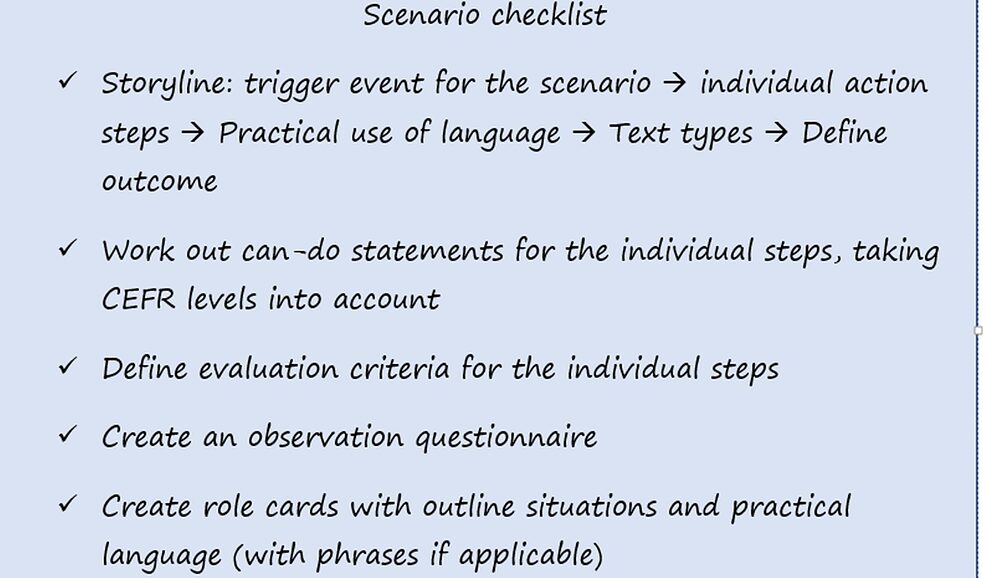Tips for german language courses for nurses
The scenario-Technique, Part II

Successfully using scenarios in vocational German language teaching in a healthcare setting. How can it work? Five tips for using scenarios in job-related German lessons to practice language and communication skills as an aspect of professional competence. Part Two: Tips three to five.
By Dr. Neda Sheytanova
TIP 3: Determining language and communication requirements: identifying practical language situations, taking language register into account
Now you’re already familiar with a few workplace communication situations in a healthcare setting, and you decide on a scenario with three action steps in the following logical sequence: Step 1: Handover at the end of a shift | Neda Sheytanova
Step 1: Handover at the end of a shift | Neda Sheytanova
 Step 2: Mobilisation by sitting patient on the edge of the bed and in a wheelchair | Neda Sheytanova
Step 2: Mobilisation by sitting patient on the edge of the bed and in a wheelchair | Neda Sheytanova
 Step 3: Personal care in the bathroom | Neda Sheytanova
The three target situations describe the tasks and/or professional demands the learner needs to cope with in their work routine.
Step 3: Personal care in the bathroom | Neda Sheytanova
The three target situations describe the tasks and/or professional demands the learner needs to cope with in their work routine.
- What do people say in these situations, and how do they communicate?
- What language and communication skills do learners need to be able to handle these specific professional situations effectively?
Language analysis of relevant situations in the healthcare setting shows that practical language skills can be grouped into the following categories:
 Graphic | Neda Sheytanova
The next step is to examine the pure language aspects: what vocabulary and specialist expressions are needed in the given situation? What grammar does the learner need to master in order to implement their practical language adequately? Which language structures should be practised in the lessons?
Graphic | Neda Sheytanova
The next step is to examine the pure language aspects: what vocabulary and specialist expressions are needed in the given situation? What grammar does the learner need to master in order to implement their practical language adequately? Which language structures should be practised in the lessons?However, successful communication does not just mean having a command of the specialist vocabulary and being able to implement the practical language correctly. If anything, more important roles are played by the different language registers[1], body language, proxemics (spatial awareness) and intonation.
In the action chains defined here the following language registers are found:
- Patient language: communication with patients/residents
- Specialist language: intra-disciplinary communication with colleagues
For the purposes of scenario creation that means: when defining the language/communication requirements arising in the action steps of a scenario, a variety of aspects are taken into account: intercultural, specific to gender and age as well as workplace and hierarchy – but text and language types are also identified.
TIP 4: Formulating can-do statements
Once the practical language skills have been identified and the language/communication demands in the situations have been defined, you’re a huge step closer to creating a scenario for your vocational course.The practical language skills you’ve identified form the basis for formulation of the can-do statements, and in this context the CEFR matrix should be used for orientation with reference to language levels. The type of communication for each individual situation is defined, taking the CEFR levels into account[2]:
- How well are the practical language skills performed in the individual action steps?
Situation: handover
B1: The learner can …- present the current care status of the patient and the resulting changes in care planning within the context of handover, even if there are difficulties with word choice that do not affect understanding too significantly.
- react and act to situational requirements routinely, using familiar language patterns and as smoothly as possible.
- present the current care status of the patient and the resulting changes in care planning within the context of handover in detail and in a clearly understandable way.
- react and act to situational requirements flexibly and in a style appropriate to the address.
For the scenario this means that the language requirements and therefore expectations of language performance can be adapted depending on the learning status of individual learners. Setting expectations too high or low should be avoided, because both lead to frustration and reluctance to participate actively in the scenario.
At the same time the scenario offers the opportunity for differentiation within the class by creating role cards flexibly depending on language needs (see TIP 5).
TIP 5: Creating role cards
Once the relevant can-do statements have been completed for all practical language skills at the required language levels in the situations of your scenario, you have fulfilled the crucial conditions. Your next task is to formulate the role cards in which the situations, actors and their tasks are described precisely.To achieve differentiation within the class, the role cards can also contain phrases that will help the first time the scenario is practised in class and/or for weaker learners.
 Scenario checklist | Neda Sheytanova
Adapting for the classroom: preparation for the action step “Handover”
Scenario checklist | Neda Sheytanova
Adapting for the classroom: preparation for the action step “Handover”EDITOR'S NOTE:
Tips for german language courses for nurses: The scenario-Technique, Part I
Literature
- [1] Language register refers to the appropriateness of the mode of expression towards the communication partner in a specific communication situation, which involves consideration of language norms (e.g. linguistic politeness) and appropriate use of language (e.g. adiposity – obesity – overweight).
- [2] Language proficiency level orientation is on the basis of the Common European Framework of Reference for Languages (CEFR), although CEFR is not prescriptive in this capacity but merely serves to provide a structure. A further recommended reference is the document “Arbeitsplatz Europa”: https://www.dihk-verlag.de/arbeitsplatz_europa_deutsch.html, published by the Deutsche Industrie- und Handelskammer and last viewed 14.02.2021
- Szenarien im berufsbezogenen Deutschunterricht Deutsch als Zweitsprache, Anne Sass, Gabriele Eilert-Ebke, published by passage gGmbH, Hamburg 2014, https://www.deutsch-am-arbeitsplatz.de/fileadmin/user_upload/PDF/BD_Szenarien_2014_web.pdf, last viewed: 16.02.20121.
- Ein Tag Deutsch in der Pflege: https://www.ein-tag-deutsch.de/, last viewed 16.02.2021.